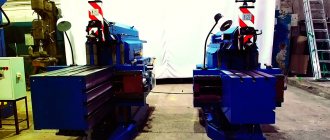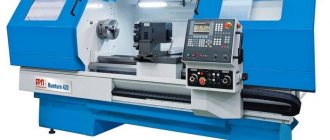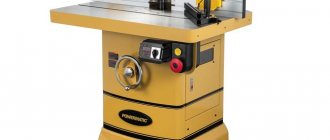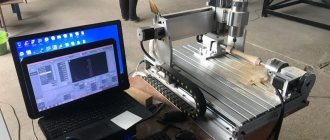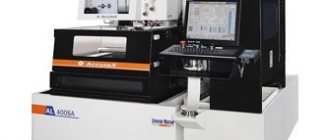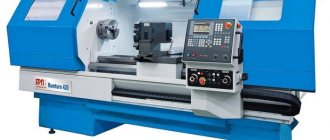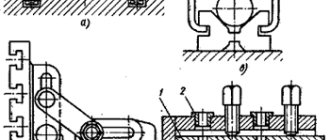Purpose of the machines
Milling machines of this type have three main purposes. These include the following:
- processing end products with a milling machine - axles, shafts and other round-shaped components;
- carrying out preparatory work for surfaces that will be processed with a milling machine at the next stage - forming holes in the end sides of the parts;
- Some machine models are equipped with a function for removing working chamfers.
Let us highlight that most milling and centering equipment involves simultaneous processing of two end parts at once, which speeds up the production process and increases the turnover of finished products. This is especially convenient in large enterprises.
Advantages of a special CNC milling and centering machine SM2484F3:
- high processing accuracy, which is ensured by the presence of linear guides in the power table and faceplate, as well as the Siemens CNC system;
- high quality of processed surfaces due to the use of the turning method and increased rigidity of the machine.
- flexibility and ease of changeover for the production of chamfers of any profile;
- minimal costs and speed of changeover when switching to processing new chamfers;
- the ability to remove the internal seam on straight sections of bends;
- reliability and durability in operation, the ability to work in 3 shifts without days off.
- Possibility of end boring with wall thickness up to 15mm.
Principle of operation
This is not to say that the work process is particularly complex, but only qualified employees are allowed to work on the equipment. So, the operating principle of a milling-centring machine is as follows.
The metal workpiece is placed in a vice specially designated for this purpose, and is well fixed in a stationary position. A milling cutter is started, which processes one part from both sides, ensuring maximum symmetry. The processing head “drills” the center hole according to the specified parameters.
The finished product, as a rule, after the milling machine, is treated with special brushes with a certain rigidity, which remove metal shavings and make the surface smooth. After the work is completed, the part is released for sale.
Processing scheme
Let's look at the processing scheme in more detail:
- after fixing the workpiece in a vice, the machine starts the milling process, which begins to be carried out using the transverse movement of the equipment heads with the provided drill pairs;
- after moving the carriage in the transverse plane, the drilling spindles begin work, making it possible to prepare the working surface for the formation of holes;
- Next comes the process of milling the center holes.
Depending on the type and model of the milling and centering machine, the processing scheme may vary slightly. However, in general, the sequence of the process is exactly this.
Machine specifications
The milling-centring equipment includes a number of main units that are responsible for performing the main processes. First of all, this is a bed that has a pair of guides. It belongs to the base of the machine. Important components also include the carriage, on which two spindles are securely fastened - a drilling and a milling spindle. The hydraulic vice is also classified as the main unit.
In addition to the main specification, the equipment has additional components and mechanisms. These include control systems and operational functionality. Please note that the equipment may vary depending on the machine model and its equipment at the manufacturer.
Information about the manufacturer of the central turning machine 2G942
The manufacturer of central turning machines 2G942 is the Kostroma plant of automatic lines KZAL , founded in 1968.
Already in 1969, the first 4 modular machines were produced.
In 1972, the plant mastered the production of semi-automatic milling and centering machines. After the commissioning of new workshops and specialized areas, the first automatic lines were produced in 1975.
Machine tools produced by the Kostroma Automatic Line Plant KZAL
- 2G942
- semi-automatic milling and centering machine Ø 160 x 1000 - MP-71M
- semi-automatic milling-centring-turning machine Ø 125 x 500
Specifications
The technical characteristics of milling and centering machines depend on the model of the equipment and its equipment. However, there are a number of general indicators that are established by GOST. For example, the material used to make machines is hardened tool steel with a low carbon content. It is this that extends the life of the unit and makes it as resistant to external loads and mechanical damage as possible.
The material that the machines process is steel or durable cast iron. Non-ferrous metals of high strength and hardness are also used. Almost all equipment models are capable of milling steel with inserted alloy parts.
terms of Use
Milling and centering equipment must be operated in equipped rooms - workshops, where effective artificial and natural ventilation is provided. The area of the room must be of such size that during operation of the machine or its downtime there is quick and free access to any of its mechanisms.
Sharpening of individual tools that are included with the unit must be carried out as required. That is, when the cutting part of the tool becomes dull. When using the machine, it is important to ensure that the workpieces are securely fixed in the vice to avoid industrial accidents.
In cases where the cutter begins to crumble (visually determined by the presence of metal chips or sharp nicks on the part), it must be replaced. Otherwise, the milling of holes will result in deformations and defects. During the operation of the machine, it is important to monitor all actions, which is carried out directly by the operator and the turner.
Features of operation of milling-centring equipment
When operating equipment of this class, it is first necessary to control the ease of movement of the table by manual feed. If you find any problems (too tight movement, for example), you will need to loosen the locking clamps and then recheck the quality of movement.
If vibrations occur, you need to stop the machine and take all possible measures to get rid of them. To do this, it is necessary to carefully examine the condition and reliability of the fastening of the cutter and workpieces, as well as special devices used in various cutting modes.
Installation and change of cutter
Before securing the cutter in the spindle, the worker will have to perform the following preparatory operations:
- Check the condition and quality of sharpening of the tool, which should not show obvious signs of cracks, burns or crumbling of the material.
- You also need to make sure that the teeth fit firmly in the cutter body and check their wear after intensive use of the equipment.
- In a situation where the cutting edges are very dull or slightly crumbled, the tool will need to be replaced with a new sample.
Additional Information! During the adjustment process, it is also necessary to ensure that dirt and cleaning cloth residues do not accumulate on the settling surfaces of the milling mandrel, as well as on the collet and spindle.
Upon completion of fixing the cutter in the spindle, it is necessary to check the level of runout of the cutting edges of the tool.
Next, you will need to configure the feeds to the modes specified in the task, after which you can install and fix the stops of the automatic shutdown mechanism.
Safety regulations
To ensure safe operation of milling and centering equipment, a number of requirements must be met. First of all, workers must have special clothing that has a fixation to avoid wrapping around the spindle. Secondly, a headdress that protects your hair. It is also important to wear special glasses that prevent metal shavings and sparks from getting into your eyes. Mittens should be made of dense fabric that ensures safe work with hot and sharp parts.
The room in which milling work is carried out must meet the requirements of GOST. It is mandatory to install a fire alarm system connected to the water supply. There should be no flammable raw materials near the machine operation that could ignite or explode due to sparks. The room must have high-quality lighting, which allows you to easily carry out work with small and large parts.
Also, for safety reasons, special warehouses or racks must be provided that are used for storing and packaging finished parts. It is prohibited to store finished products in the immediate vicinity of a working machine, since easy access to the equipment from any side must be ensured.
In cases of a short circuit, machines must be turned off immediately, regardless of the stage of product readiness. All equipment must be grounded and have fuses. Also, machines must have quality certificates from the manufacturer, which confirm the safety of the units.
What does a passport look like?
A passport is a necessary document issued by the manufacturer for each milling and centering machine. It must meet certain requirements and include:
- general information about the machine;
- photographs showing both the main components of the unit and general photos;
- all the necessary characteristics corresponding to this or that equipment;
- complete set that is included in the machine or attached to it;
- safety rules that are observed during installation, dismantling and operation;
- mechanism lubrication system and instructions;
- device of a milling and centralizing machine;
- instructions for use;
- instructions for transportation and installation.
Please note that the manufacturer is required to provide a passport. In case of failure, it is not recommended to purchase the machine for your own safety. In addition, if equipment is purchased for production, problems may arise with inspection services, which will also not benefit the owner of the enterprise.
ZAH series special purpose machines
A series of machines designed to perform a large series of operations on shaft-type parts.
High productivity, a wide range of operations, simple reconfiguration and ease of maintenance determined the main purpose of the machines - serial production of parts.
ZAH 620 CNC
Machine for turning, drilling, threading for rotating workpieces.
ZAH 2000 CNC
Centering machine with functions of milling, threading, drilling with automatic tool change. The main feature of this machine is that the workpiece remains stationary while the tool rotates.
ZAH 2400 1S CNC
Automatic, scoring, centering and turning center with rotating workpiece.
The overall concept of the center is aimed at minimum overall dimensions with maximum use of work space. A large access area to the workspace, simple and quick service accessibility to individual mechanisms make the machine convenient for use in large-scale production. The high rigidity of the cast iron structure of individual machine elements (bed, spindle, supports, tool heads) is a guarantee of high and stable accuracy under long-term multi-shift load. Individual components are selected to be low maintenance (or maintenance free) with easy service accessibility. The most important characteristic is the principle of a rotating workpiece in a supporting spindle, which has several advantages compared to standard clamped workpieces and rotating tools:
- turning of internal and external dimensions without profile restrictions using standard turning tools - high geometric accuracy (parallelism) of the cut planes - important for subsequent processing (service life of end clamps on a lathe) - turning of shaped recesses with standard tools - drilling and tapping by any means for each machined side of the workpiece - up to 8 different tools can be used for each side of the workpiece - shortest machine hours - tool change 0.4 sec - independent programming of processing of each side of the workpiece - minimization of rotating inert masses
| The main prerequisite for long-term stability and high productivity is the cast iron base of the machine, including the individual groups (longitudinal and transverse supports). The inclination of the bed under the cross slides has been optimized, taking into account trouble-free chip removal and a machine width of 30°. The guide planes of the longitudinal slide and tailstock are hardened and ground (the opposite planes are lined with antifriction material TURCITE B and scraped). | |
| Spindle The cast iron spindle body is screwed to the base of the bed with the possibility of alignment in the event of a possible collision. The spindle itself is secured using a pair of bearings with an oblique joint. The spindle bearings, given the high circumferential speeds, are lubricated with spray oil, which ensures optimal lubrication and cooling of the bearings. The bearings are sealed by labyrinth rings. The power of the main driven motor is transferred in this gear ratio by an HTD type timing belt directly to the spindle. The spindle speed is measured directly from the spindle motor. | |
| Longitudinal and transverse supports The base of the longitudinal and transverse supports are cast iron. The guide surfaces are coated with anti-friction material TURCITE B and smoothed. Feeds in both axes are realized using backlash-free ball screws, fastening is realized with backlash-free bearings from INA, direct connection in axes X1, X2 and Z1,Z2 (without intermediate gear) with servomotors is provided with torsion-free backlash couplings. Each axis is measured using photoelectronic rotary position sensors, which are built directly into the digital servomotors. | |
| Tool heads The TMRA160 electronic tool heads are controlled by a servo motor and equipped with an 8-position tool disk, allowing the mounting of 20 x 20 mm tool holders or rotary tools with a 25 mm shank diameter. The coolant is supplied through the tool disc directly to the body of the cutter holder itself. | |
| Control system The standard technical version of the machine is equipped with a control system SINUMERIK 840 D Sl from SIEMENS with the following basic configuration: - NCU 572.4 processor - OP 010C + MCP 483 - PCU 50 operator interface with SW with language switching We are talking about a fully digital system with integrated controllers spindle and feeds Simodrive 611. | |
ZAH 2700 CNC
The special ZAH 2700 TC CNC machine is designed for simultaneous machining of the ends of railway axles on both sides. The machine can perform sawing of profits, milling of the end surface, centering and drilling of holes, as well as cutting threads on the ends of the axles. The machine is designed with the maximum possible working space with minimal overall dimensions. Easy access to the working area and the openness of the machine’s CNC system allow the machine to be used in automated production conditions. The main structural elements (base, bed, caliper housings) of the machine are made of cast iron to ensure stable processing during long-term operation. All units are designed for ease of maintenance and repair.
Functional elements of the machine:
| Tool heads C1, C2 Electric tool heads from | |
| Lubrication system for machine components The machine has an independent lubrication unit and separate automatic equipment for supplying oil to the required places: - on horizontal guides - on vertical guides - in ball screw units. Lubrication control is provided by a switch and in case of a defect, the machine control system gives a signal. The remaining parts (spindle bearings, etc.) are lubricated with permanent grease. | |
| Hydraulic unit of the machine The hydraulic unit is located at the rear of the machine and performs the following functions: securing the workpiece; tool release in the spindle. Technical parameters: - tank volume - 40 liters - engine power - 2.5 kW - operating pressure - 12 MPa - cleaning parameter - 20 microns | |
| Chip conveyor, coolant cooling and cleaning The chip conveyor is part of the machine's cooling system. To prevent accidental entry of chips into the coolant reservoir, the conveyor is equipped with mechanical barriers (grids). Tank volume - 260 liters. From the reservoir, the emulsion is pumped through a special MAHLE filter. The standard lifting height of chips for dumping into a box is 800 mm. | |
| CNC control system As standard, the machine is equipped with a control system SINUMERIK 840 D Sl from SIEMENS in the following basic configuration: - Operator panel OP010C, 19", 10.4" TFT - MCP 483C IE panel, keyboard - PCU 50.3-P module, 2.0 GHz / 1024 MB, Win XP - Sinumerik 840D sl, NCU 720.2 with PLC 317-2DP | |
| Machine PLC system The control system is expanded with the SIMATIC S7-300 PLC machine, which is connected via a PROFIBUS DP interface and exchanges control signals for machine functions, as well as full operational and emergency diagnostics. | |
What determines the cost of equipment
The price of a centering milling machine depends on a number of factors. First of all, it is power, efficiency and productivity. The higher these indicators, the more expensive the machine. The price is also affected by its size, basic and additional equipment.
Other characteristics also affect the cost of equipment. For example, the thickness of the material being processed, the metal from which the equipment is made, the warranty period. Functionality also accounts for the price. If, in addition to milling, the machines have additional functions and any automated mechanisms, the final cost of the unit will be higher.
Please note that the price is also affected by the region in which the purchase is made. Thus, in small cities the cost of the machine will be an order of magnitude lower than in large cities. In addition, it is recommended to purchase units directly from the supplier, and not through resellers. This will help you save a considerable amount. However, do not forget that you will have to spend money on transportation to the workshop by hiring a truck with a large carrying capacity.
Overview of models for industrial production
There are a number of models of milling and centering machines that are widely used in large enterprises. They allow you to quickly and accurately perform their work, have additional functions, and consume a small amount of electricity. Let's look at the most basic models.
The EM535M, MP71M and MP76M machines are distinguished by high power, a large number of processed materials, and wear resistance. They allow the production of finished end products up to 1 meter long and up to 16 cm thick. They have several spindle speeds and are supplied with several milling heads of different diameters.
Also noted are the 2G942 and MP-71 machines, which have automatic loading devices that ensure an accelerated workflow even at the largest enterprises. Used independently or in a conveyor line. Powerful, durable, stable and reliable. Meets GOST requirements and does not require special maintenance.
Review of models for the home workshop
For metal processing at home, as a rule, budget machines are chosen. Of course, price is of great importance, since inexpensive units usually perform a limited range of functions. But if we are talking about home use and not for industrial purposes, such equipment will be ideal.
Home models are characterized by maximum compactness, low weight, and low noise levels during the working process. These include models 6B75V and AF222. They are quite powerful and allow you to process parts made of steel and cast iron. They work quickly and efficiently. Great for small parts.
To summarize, milling and centering machines are indispensable equipment for the production of metal end parts. They allow you to quickly and efficiently mill holes inside, which is necessary for the manufacture of metal components for machines and mechanisms. Today the market allows you to buy both budget models and more expensive ones. Manufacturers offer a large selection of equipment for each consumer, which makes it easy to choose the right unit for personal or industrial purposes.
Good luck with your choice!
Which machine to choose for a home workshop: advantages and disadvantages of models
Milling machines for home workshops resemble drilling machines, which also include a frame and a column with a spindle mounted vertically on it. Unlike factory models, they provide a special mechanism for moving the table under the working cutter, which allows you to grind the part in three planes.
Important! If you have the appropriate equipment, you can use household equipment to process workpieces made of any materials (not just metal).
Before choosing a machine for home use, you need to consider the following parameters:
- Height of the spindle above the work table.
- Permissible milling diameters.
- Machine power.
- Ease of installation and connection of equipment, as well as its weight.
The correct choice of the first of these parameters allows you to install a fairly large workpiece, and the power of the machine allows you to expand its functionality.
This parameter for household equipment can vary in the range from 150 to 750 watts.

